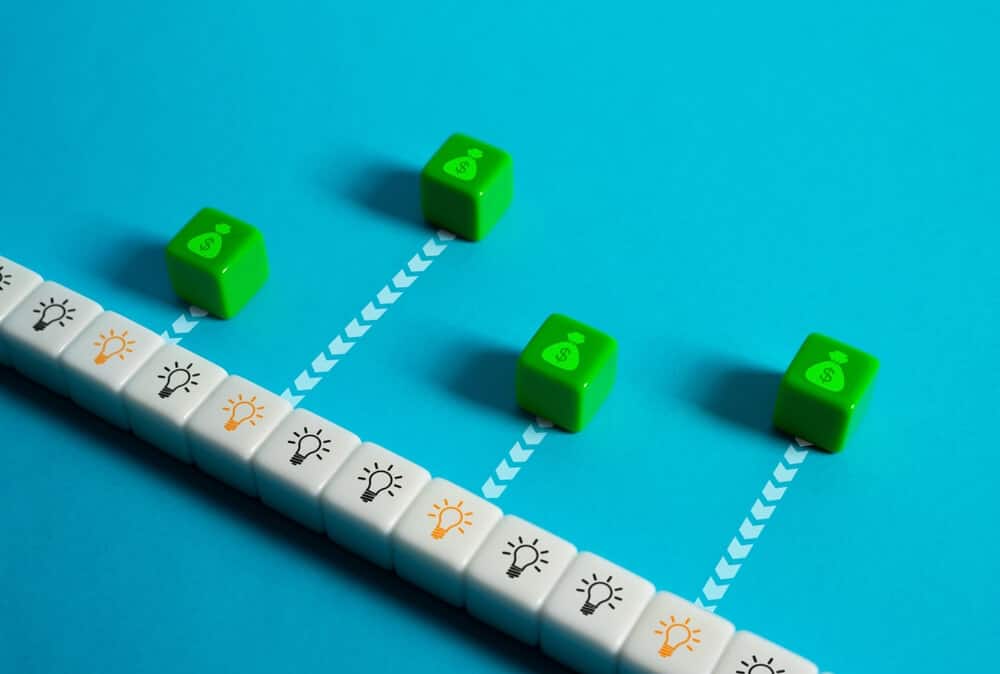Have you ever wondered what it really takes to bring a new product to market? If you’re an entrepreneur or product manager, you’ve probably lost sleep over how to best budget for the potential costs involved. You’re not alone. This guide breaks down the real costs of product development and provides insights to help you navigate this complex process.
Key Takeaways
- Product development costs can range from thousands to millions of dollars, varying significantly based on complexity, scale, and industry.
- Developing functional prototypes is essential for validating concepts and managing costs effectively in physical product development.
- Team composition and location can greatly impact development expenses, with outsourcing often providing cost-effective solutions for certain tasks.
Understanding the Basics of Product Development Costs
Developing a new product is rarely inexpensive, but understanding the costs involved can make or break your project’s success. So, what exactly constitutes product development costs?
At its core, product development costs encompass everything from initial concept creation to final production. This includes design, prototyping, testing, and all the nitty-gritty details in between. The cost range is wide, typically from $20,000 for simpler products to well over $1,000,000 for complex or highly innovative items.
Factors Influencing Cost Variation
The reason for such a broad range lies in the complexity of your product and the degree of customization required. A simple product with standard components naturally costs less to develop than a highly complex, fully customized item.
Consider the difference between developing a new water bottle design and creating a cutting-edge smart home device – both are product development projects, but the complexity, required expertise, and associated costs are worlds apart.
Breaking Down the Stages of Product Development
To effectively budget and plan your project, it’s crucial to understand the stages of product development and their associated costs. Here’s a breakdown:
- Concept Development and Research
-
- Cost range: $5,000 – $50,000
- Key expenses: Market research, concept testing, initial design sketches
-
- Design and Engineering
-
- Cost range: $10,000 – $100,000
- Key expenses: CAD modeling, technical drawings, material selection
-
- Prototyping
-
- Cost range: $2,000 – $50,000
- Key expenses: 3D printing, CNC machining, prototype assembly
-
- Testing and Refinement
-
- Cost range: $5,000 – $50,000
- Key expenses: User testing, performance analysis, design iterations
-
- Manufacturing Setup
-
- Cost range: $10,000 – $500,000+
- Key expenses: Tooling, molds, production line setup
-
- Initial Production Run
-
- Cost range: Varies widely based on product and volume
- Key expenses: Materials, labor, quality control
-
Each stage presents its own set of challenges and costs. The key is to approach each phase strategically, balancing budget constraints with quality requirements. It’s important to note that these ranges can vary significantly based on your specific product and industry. For instance, a medical device will likely have much higher costs due to regulatory requirements, while a simple consumer product might fall on the lower end of these ranges.

Balancing Cost and Value with Prototyping
In hardware product development, prototyping plays a crucial role. While software products often utilize the Minimum Viable Product (MVP) approach, hardware development relies more heavily on functional prototypes.
Prototyping is essential in hardware development for several reasons:
- It allows testing of product concepts with real users
- It facilitates gathering valuable feedback early in the development process
- It helps minimize initial development costs
- It reduces the risk of investing in a full-scale product that might not resonate with the market
By focusing on creating functional prototypes, you can potentially save thousands of dollars in development costs. This approach is akin to testing the waters before diving in headfirst. Moreover, the feedback gathered can be invaluable in refining your product and ensuring its long-term success.
The Impact of Team Composition on Costs
The people behind the product can significantly influence your budget. Assembling the right development team is crucial for managing costs effectively.
A typical product development team might include:
- Product Manager
- Industrial Designer
- Mechanical Engineer
- Electrical Engineer (for electronic products)
- Software Developer (for smart products)
- Manufacturing Specialist
However, the composition of your team will depend heavily on the nature of your product. For instance, developing a simple product like a t-shirt might only require a designer and a manufacturing specialist. Conversely, a complex electronic device would necessitate a full team of specialists.
Team Size and Experience Considerations
The size and experience of your team will significantly impact your costs. A larger, more experienced team can accelerate development but will also increase expenses. Conversely, a smaller team might take longer but could be more cost-effective.
Reducing Costs with Outsourcing
An interesting cost-saving strategy to consider is outsourcing. Many companies find that outsourcing certain specialized tasks can lead to significant cost savings without compromising quality. For example, hiring a dedicated team in Eastern Europe could potentially reduce development costs by 40% to 70% compared to Western rates
Regional Cost Variations: A Global Perspective
The location of your development team can have a substantial impact on your overall costs. Consider these regional differences:
- North America and Western Europe: Highest costs, but often come with top-tier expertise and innovation
- Eastern Europe: Increasingly popular for its balance of skill and cost-effectiveness
- Asia: Can offer the lowest rates, but quality and communication can sometimes be challenges
While cost is a significant factor, it shouldn’t be your only consideration. It’s important to factor in time zone differences, language barriers, and cultural nuances when deciding where to base your development efforts.
Strategies for Reducing Costs Without Compromising Quality
Keeping product development costs in check without sacrificing quality is a common challenge. Here are some strategies to consider:
- Embrace Agile Methodologies: This flexible approach to project management can help you adapt quickly to changes and reduce waste.
- Utilize Existing Components: Don’t reinvent the wheel. Using off-the-shelf components can significantly cut down on development time and costs.
- Invest in Prototyping: While it might seem counterintuitive, spending more on prototyping can actually save money in the long run by identifying issues early.
- Focus on Core Features: Resist the temptation to add every bell and whistle. Stick to what’s essential, at least initially.
- Build Long-Term Partnerships: Developing relationships with reliable suppliers and development partners can lead to cost savings over time.
The goal is to be smart about your spending, not to cut corners. Quality should always be a top priority – after all, a cheap product that doesn’t work is no bargain at all.
Case Studies: Learning from Real-World Examples
Real-world examples can provide valuable insights into effective product development strategies.
Consider the story of Juicero, a startup that launched a high-tech juicer requiring proprietary juice packs. Despite its sleek design and technological advancements, the product was criticized for being overly complicated and expensive, especially when it was discovered that the juice packs could be squeezed by hand without the machine. This case highlights the importance of ensuring that technology genuinely adds value to the user experience rather than complicating it.
Success Through Iteration and User Feedback
In contrast, companies like Smart Bedding (now known as Primary Goods) have found success by starting with simple, functional prototypes and gradually refining their product based on user feedback. Smart Bedding began with a straightforward idea to reduce bed-making time.
They created basic prototypes using craft materials to test their concept, allowing them to identify and address issues such as the ineffectiveness of magnets in their initial design. By focusing on core functionality and iterating based on real-world testing, Smart Bedding developed a successful product line that effectively met consumer needs without overextending themselves financially.
The Importance of Strategic Spending
These cases underscore a crucial point: successful product development isn’t just about having a big budget. It’s about spending wisely, understanding your market, and being willing to adapt based on real-world feedback.
Navigating the Cost Landscape
The cost of product development is undeniably complex. From the initial concept to the final production run, countless factors can impact your budget. However, armed with the right knowledge and strategies, you can navigate these challenges successfully.
Key points to remember:
- Start with a clear understanding of your product and market
- Embrace prototyping to test your concept cost-effectively
- Choose your development team wisely, considering both skill and cost
- Stay flexible and be willing to adapt your plans based on feedback and changing circumstances
Product development is an investment, and like any investment, it comes with risks. By approaching the process strategically and keeping a close eye on costs at every stage, you can minimize these risks and maximize your chances of success.
Frequently Asked Questions
What are the main factors influencing product development costs?
The main factors include project complexity, customization requirements, team composition, development location, and the extent of research and testing needed. Each of these can significantly impact your overall budget.
How can I reduce product development costs without compromising quality?
Focus on developing functional prototypes, utilize existing components where possible, embrace agile methodologies, and consider outsourcing certain tasks to cost-effective regions. Remember, the goal is to be efficient, not to cut corners on quality.
Why is prototyping important in product development?
Prototyping allows you to test your core product concept with minimal investment. It helps validate your idea, gather user feedback, and make informed decisions about further development, potentially saving significant costs in the long run.
How does the location of the development team affect costs?
Development costs can vary widely based on location due to differences in labor rates, living costs, and economic conditions. While some regions offer lower rates, it’s important to balance cost savings with factors like expertise, communication ease, and time zone compatibility.
What role do long-term partnerships play in product development?
Long-term partnerships with suppliers, manufacturers, and development teams can lead to more efficient processes, better understanding of your needs, and potential cost savings over time. These relationships can be invaluable in navigating the complexities of product development.
Partner with the Product Development Experts
Navigating the complexities of product development can be challenging, but you don’t have to go it alone. At Gembah, we’re passionate about turning innovative ideas into successful products.
Whether you’re a startup with a groundbreaking concept or an established company looking to streamline your development process, we’re here to help. Our team of experts can guide you through every stage, from initial design to final production, ensuring you maximize efficiency and minimize costs.
Ready to bring your next great idea to life? Contact Gembah today and take the first step towards optimized, cost-effective product development.



